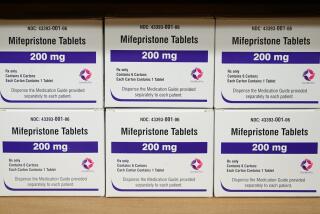A pill to prevent breast cancer? Yes, for certain women, panel says

Women with a higher-than-usual risk for developing breast cancer should consider taking one of two medications approved by the Food and Drug Administration to reduce that risk, a federal panel has concluded. But the medications, which can raise a woman’s risk of developing blood clots, are not for everyone and should not be taken for breast cancer reduction by most women, the U.S. Preventive Services Task Force said.
Taken daily by women who are more likely than most to develop breast cancer, the chemotherapy drug tamoxifen or the osteoporosis drug raloxifene have been shown to drive down that risk. The federal panel of experts said that physicians and patients should discuss taking one of those medications in cases where a woman’s risk of developing breast cancer over the next five years is calculated at 3% by one of two reliable breast cancer risk calculators. But in certain cases, a woman’s other vulnerabilities -- including a personal or family history of stroke or blood clots -- might outweigh the possible benefits of the breast cancer prevention drugs, the panel said.
The National Cancer Institute estimates that roughly 1 in 8 women born today -- 12.4% -- will develop breast cancer at some point in their lives. But many factors influence a woman’s risk, including advancing age, the age at which she began menstruating, whether she has a sister or mother who had the disease, and the density of her breasts. Those and other factors are used in the two separate calculators that can guide a woman’s decision-making: www.cancer.gov/bcrisktool/ or https://bcsc-scc.org/BC5yearRisk/.
These risk calculators, and the task force’s measured recommendations, do not apply to women who have the BRCA-1 or BRCA-2 gene mutations, which confer an extremely high risk of developing breast cancer, and they don’t apply to women younger than 35 or older than 79.
Past research has suggested that having a five-year risk of developing breast cancer that was 1.66% or greater was sufficient to justify the use of chemoprevention such as tamoxifen. But the task force suggested that, given the potential harm both medications can cause, the women who would most clearly benefit the most were those with a five-year breast-cancer probability of 3% or higher.
Women who took tamoxifen were also slightly less likely than those who did not to develop nonvertebral fractures. And women who took raloxifene -- first approved for osteoporosis -- had fewer vertebral fractures. Over four trials, however, four women developed potentially deadly blood clots for every 1,000 women who took tamoxifen. Over two trials, seven women of every 1,000 who took raloxifene developed a blood clot. Women taking tamoxifen had a higher rate of endometrial cancers, which are rarely fatal when treated, than those who did not take the drug. And women taking either medication reported more hot flashes than those who took none.
More to Read
Start your day right
Sign up for Essential California for news, features and recommendations from the L.A. Times and beyond in your inbox six days a week.
You may occasionally receive promotional content from the Los Angeles Times.







